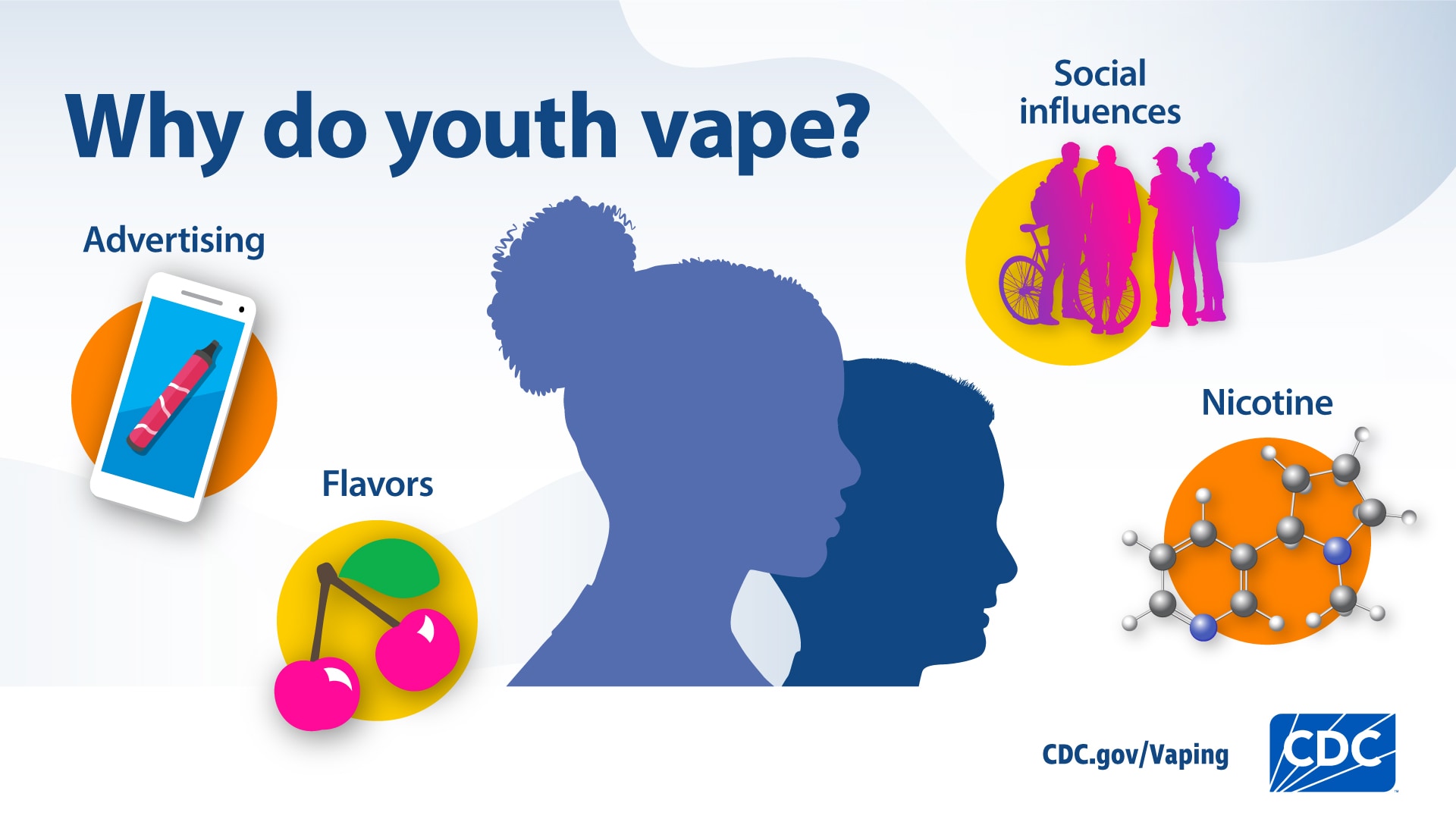What to know
There are many reasons youth might vape. E-cigarette marketing and advertising, the availability of appealing flavors, social influences, and the effects of nicotine all play a role in why youth start and/or continue to vape.
Tobacco advertising
Widespread advertising for e-cigarettes has contributed to youth vaping.1 Tobacco companies use the same advertising themes and tactics that have been shown to increase youth initiation of cigarettes and other tobacco products. They also place ads on television and in other media where ads for other tobacco products, like cigarettes, are not allowed.
In 2021, 7 in 10 U.S. middle and high school students reported exposure to e-cigarette marketing. Most students reported seeing e-cigarette ads or promotions in retail settings. Students also reported seeing ads on the Internet, television, streaming services, or movies, or in print media. In addition, about three in four (74%) students who used social media had seen e-cigarette–related posts or content.2
Some e-cigarettes cost less than regular cigarettes, which may also contribute to youth vaping.1

Availability of flavored products
Most U.S. middle and high school students who vape use flavored products.3 Vapes come in a variety of youth-friendly flavors, including fruit, candy, mint, and menthol.
A study from 2013–2015 showed that most youth who use e-cigarettes first start with a flavored variety.4 Availability of flavored vapes is among the top 10 reasons youth report ever trying an e-cigarette.2 In 2024, nearly 9 out of 10 middle and high school students who currently used e-cigarettes used a flavored product. The most commonly used flavors reported by these students were fruit, candy, and mint.3

Social influences
The most common reason U.S. middle and high school students give for trying an e-cigarette is that a friend used them. Youth also report vaping because they are curious about e-cigarettes or because a family member used them.2
Youth often obtain the e-cigarettes they use from others. Among U.S. middle and high school students who used e-cigarettes in 2021:2
- 32.3% got them from a friend.
- 31.1% bought the products themselves.
- 28.7% had someone else buy the products for them.
- 21.7% had someone offer the products to them.

Nicotine
Nicotine is the main addictive substance in tobacco products, including e-cigarettes.15 With repeated use, a person's brain gets used to having nicotine. This can make them think they need nicotine just to feel okay. This is part of nicotine addiction.
Young people can start showing signs of nicotine addiction quickly, sometimes before the start of regular or daily use.67 Because the adolescent brain is still developing, it is uniquely susceptible to nicotine.1
What may start as social experimentation with vaping can become an addiction. The most common reason students give for trying an e-cigarette is "a friend used them." The most common reason they give for currently using e-cigarettes is "I am feeling anxious, stressed, or depressed."2 Nicotine addiction or withdrawal can contribute to these feelings or make them worse.89 Youth may use tobacco products to relieve their symptoms, which can lead to a cycle of nicotine addiction.89
The nicotine content of e-cigarettes has increased over time.1011 Many e-cigarettes contain nicotine salts.10 These allow people to consume high levels of nicotine without experiencing the harshness of freebase nicotine.12
High-nicotine products dominate U.S. e-cigarette unit sales. In March 2022, products with a nicotine strength of 5% or more made up 81% of total e-cigarette unit sales. In recent years, the price of high-nicotine products decreased or stayed the same while the price of low-nicotine products increased.10
- U.S. Department of Health and Human Services. E-cigarette Use Among Youth and Young Adults: A Report of the Surgeon General. Centers for Disease Control and Prevention; 2016. Accessed Feb 14, 2024.
- Gentzke AS, Wang TW, Cornelius M, et al. Tobacco product use and associated factors among middle and high school students—National Youth Tobacco Survey, United States, 2021. MMWR Surveill Summ. 2022;71(No. SS-5):1–29.
- Jamal A, Park-Lee, E, Birdsey J, et al. Tobacco product use among middle and high school students — National Youth Tobacco Survey, United States. MMWR Morb Mortal Wkly Rep. 2024;73(41):917–924.
- Villanti AC, Johnson AL, Glasser AM, et al. Association of flavored tobacco use with tobacco initiation and subsequent use among US youth and adults, 2013-2015. JAMA Netw Open. 2019;2(10):e1913804.
- U.S. Department of Health and Human Services. The Health Consequences of Smoking: 50 Years of Progress. A Report of the Surgeon General. Centers for Disease Control and Prevention; 2014. Accessed Feb 12, 2024.
- DiFranza JR, Rigotti NA, McNeill AD, et al. Initial symptoms of nicotine dependence in adolescents. Tob Control. 2000;9(3):313–319.
- DiFranza JR, Savageau JA, Fletcher K, et al. Symptoms of tobacco dependence after brief intermittent use: the Development and Assessment of Nicotine Dependence in Youth-2 study. Arch Pediatr Adolesc Med. 2007;161(7):704–710.
- U.S. Department of Health and Human Services. Smoking Cessation. A Report of the Surgeon General. Centers for Disease Control and Prevention; 2020. Accessed Feb 13, 2024.
- U.S. Department of Health and Human Services. How Tobacco Smoke Causes Disease: The Biology and Behavioral Basis for Smoking-Attributable Disease. A Report of the Surgeon General. Centers for Disease Control and Prevention; 2010. Accessed Feb 13, 2024.
- Ali FRM, Seaman EL, Crane E, Schillo B, King BA. Trends in US e-cigarette sales and prices by nicotine strength, overall and by product and flavor type, 2017-2022. Nicotine Tob Res. 2023;25(5):1052–1056.
- Romberg AR, Miller Lo EJ, Cuccia AF, et al. Patterns of nicotine concentrations in electronic cigarettes sold in the United States, 2013-2018. Drug Alcohol Depend. 2019;203:1–7.
- Leventhal AM, Madden DR, Peraza N, et al. Effect of exposure to e-cigarettes with salt vs free-base nicotine on the appeal and sensory experience of vaping: a randomized clinical trial. JAMA Netw Open. 2021;4(1):e2032757.
